#ScrumMaster
The 14 Most Valuable IT Certifications
04 June 2022
BY SCOTT M. GRAFFIUS | ScottGraffius.com

Click here to download this article as a PDF.
In Technology, there's no substitute for experience. However, certifications remain a valuable tool for advancing one's career. Employers want candidates (and employees) with up-to-date knowledge and skills, and certifications demonstrate a person’s mastery of the respective subject. The author reviewed data from multiple sources — including BMC, CIO, Clearance Jobs, Indeed, and Robert Half — to determine the consensus on the most valuable Technology related certifications. Fourteen emerged. Here they are, in alphabetical order:
If you're interested in learning about the project management related certifications, visit the Scrum Alliance for the Certified ScrumMaster (CSM) and the Project Management Institute for the Project Management Professional (PMP).
Many employers prefer to hire certified professionals, especially those who also have college degrees and successful work experience. Those who invest in professional credentials typically enjoy larger salaries.

Sources:


Post-Publication Notes
If there are any supplements or updates to this article after the date of publication, they will appear here.
This article by Scott M. Graffius on the most valuable IT certifications was published in 2022. Graffius periodically refreshes his work. The most current (2024) edition of his report is here.



About Scott M. Graffius

Scott M. Graffius, PMP, CSP-SM, CSP-PO, CSM, CSPO, SFE, ITIL, LSSGB is an agile project management practitioner, consultant, multi award-winning author, and international speaker. He has generated over $1.75 billion of business value in aggregate for the organizations he has served. Graffius is the founder, CEO, and principal consultant at Exceptional PPM and PMO Solutions™ and subsidiary Exceptional Agility™. Content from his books (Agile Scrum: Your Quick Start Guide with Step-by-Step Instructions and Agile Transformation: A Brief Story of How an Entertainment Company Developed New Capabilities and Unlocked Business Agility to Thrive in an Era of Rapid Change), workshops, speaking engagements, and more have been featured and used by businesses, professional associations, governments, and universities including Microsoft, Oracle, Broadcom, Cisco, Gartner, Deloitte, EY, Project Management Institute, IEEE, SANS Institute, U.S. Soccer Federation, English Institute of Sport, Ford, Qantas, Atlassian, Wrike, Bayer, National Academy of Sciences, United States Department of Energy, United States Army, United States National Park Service, New Zealand Ministry of Education, Amsterdam Public Health Research Institute, Tufts University, Texas A&M University, Warsaw University of Technology, University of Waterloo, National University of Ireland Galway, Zurich University of Applied Sciences, and others. Graffius delivers dynamic and engaging talks and workshops at public and private/corporate events. His engagements total 78 in-person and online conferences and other events around the world, including Armenia, Australia, Brazil, Canada, Czech Republic, Finland, France, Germany, Greece, Hungary, India, Ireland, Lithuania, Luxembourg, Nepal, Netherlands, New Zealand, Sweden, Switzerland, United Arab Emirates, United Kingdom, and the United States. Graffius delights audiences with sessions on technology leadership and project, program, portfolio, and PMO management inclusive of agile, waterfall, and hybrid approaches. He uses everyday language and vibrant custom visuals to make complex topics clear, and he provides audiences with practical information they can use.
His full bio is available here.
Connect with Scott on:
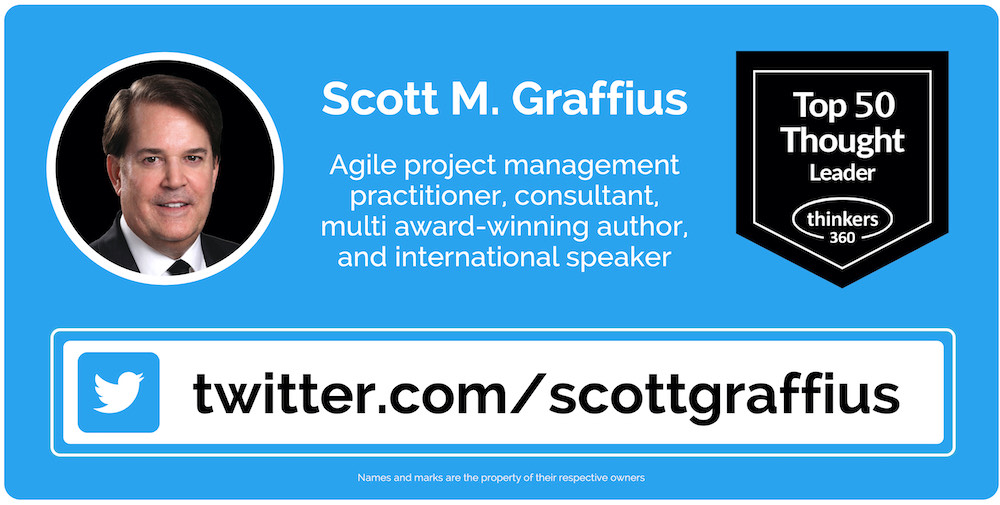

About Agile Scrum: Your Quick Start Guide with Step-by-Step Instructions
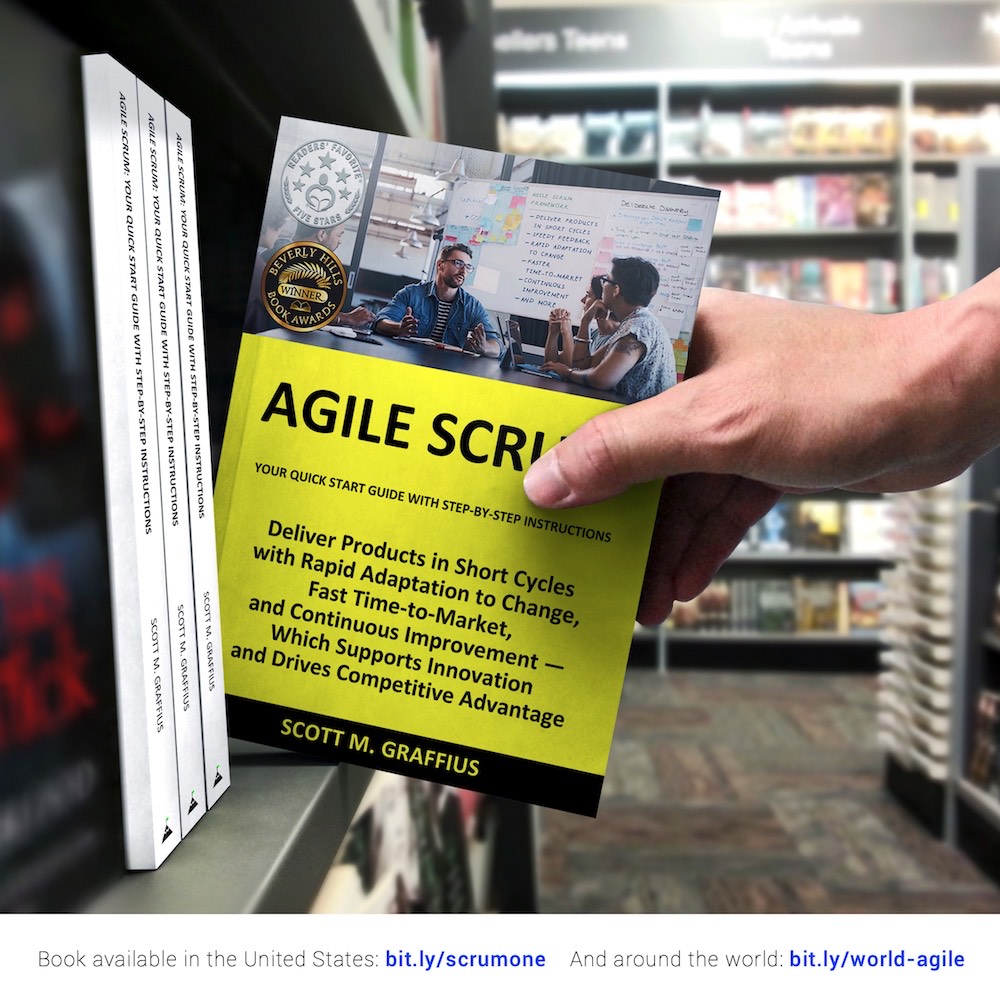
Shifting customer needs are common in today's marketplace. Businesses must be adaptive and responsive to change while delivering an exceptional customer experience to be competitive.
There are a variety of frameworks supporting the development of products and services, and most approaches fall into one of two broad categories: traditional or agile. Traditional practices such as waterfall engage sequential development, while agile involves iterative and incremental deliverables. Organizations are increasingly embracing agile to manage projects, and best meet their business needs of rapid response to change, fast delivery speed, and more.
With clear and easy to follow step-by-step instructions, Scott M. Graffius's award-winning Agile Scrum: Your Quick Start Guide with Step-by-Step Instructions helps the reader:
Hailed by Literary Titan as “the book highlights the versatility of Scrum beautifully.”
Winner of 17 first place awards.
Agile Scrum: Your Quick Start Guide with Step-by-Step Instructions is available in paperback and ebook/Kindle in the United States and around the world. Some links by country follow.

About Agile Transformation: A Brief Story of How an Entertainment Company Developed New Capabilities and Unlocked Business Agility to Thrive in an Era of Rapid Change
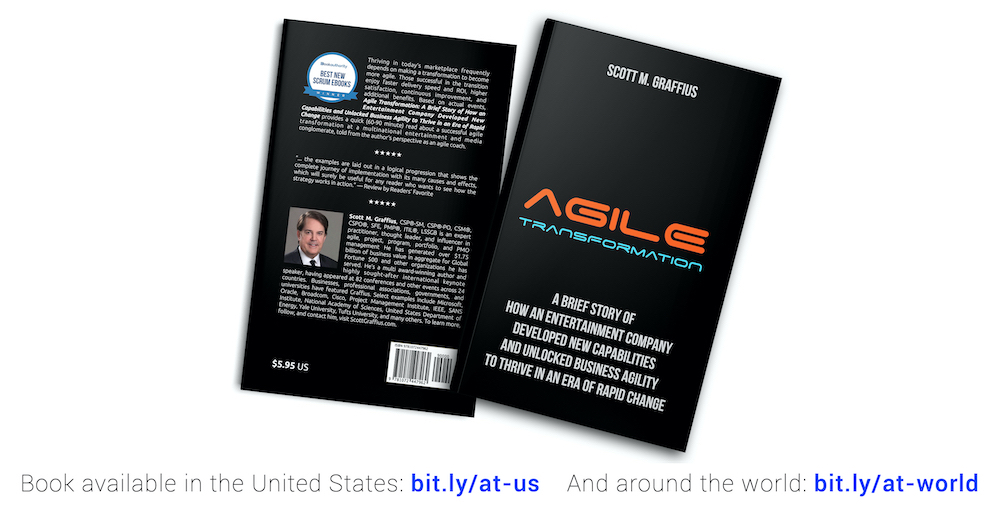
Thriving in today's marketplace frequently depends on making a transformation to become more agile. Those successful in the transition enjoy faster delivery speed and ROI, higher satisfaction, continuous improvement, and additional benefits.
Based on actual events, Agile Transformation: A Brief Story of How an Entertainment Company Developed New Capabilities and Unlocked Business Agility to Thrive in an Era of Rapid Change provides a quick (60-90 minute) read about a successful agile transformation at a multinational entertainment and media company, told from the author's perspective as an agile coach.
The award-winning book by Scott M. Graffius is available in paperback and ebook/Kindle in the United States and around the world. Some links by country follow.

The short link for this article is: bit.ly/14-certs
© Copyright 2022 Scott M. Graffius. All rights reserved. This material may not be published, broadcast, rewritten or redistributed without the express written permission of Scott M. Graffius.


Click here to download this article as a PDF.
In Technology, there's no substitute for experience. However, certifications remain a valuable tool for advancing one's career. Employers want candidates (and employees) with up-to-date knowledge and skills, and certifications demonstrate a person’s mastery of the respective subject. The author reviewed data from multiple sources — including BMC, CIO, Clearance Jobs, Indeed, and Robert Half — to determine the consensus on the most valuable Technology related certifications. Fourteen emerged. Here they are, in alphabetical order:
- AWS Certified Cloud Practitioner
- Certified Cloud Security Professional (CCSP)
- Certified Data Privacy Solutions Engineer (CDPSE)
- Certified Data Professional (CDP)
- Certified Ethical Hacker (CEH)
- Certified Information Security Manager (CISM)
- Certified Information Systems Security Professional (CISSP)
- Certified ScrumMaster (CSM)
- Cisco Certified Network Professional (CCNP)
- CompTIA (A+, Cloud+, Security+)
- Information Technology Infrastructure Library (ITIL)
- Oracle MySQL Database Administration
- Project Management Professional (PMP)
- Salesforce Certified Development Lifecycle and Deployment Designer
If you're interested in learning about the project management related certifications, visit the Scrum Alliance for the Certified ScrumMaster (CSM) and the Project Management Institute for the Project Management Professional (PMP).
Many employers prefer to hire certified professionals, especially those who also have college degrees and successful work experience. Those who invest in professional credentials typically enjoy larger salaries.

Sources:
- Hamilton, Jillian (2021, July 9). Top 10 IT Certifications Held by Cleared Professionals. Clearance Jobs. Accessed at https://news.clearancejobs.com/2021/07/09/top-10-it-certifications-held-by-cleared-professionals-2/.
- Miller, Austin (2021, June 25). Top Paying IT Certifications in 2022. BMC Software, Inc. Accessed at https://www.bmc.com/blogs/top-paying-it-certifications/.
- Robert Half (2021, September 9). The 29 Most Valuable IT Certifications. Robert Half. Accessed at https://www.roberthalf.com/blog/salaries-and-skills/which-it-certifications-are-most-valuable.
- Vallee, Megan (2022, March 4). 21 IT Certifications in Demand for 2022. Indeed. Accessed at https://www.indeed.com/career-advice/career-development/top-it-certifications.
- White, Sarah K. (2022, January 14). Top 15 IT Certifications in Demand for 2022. CIO. Accessed at https://www.cio.com/article/193586/top-15-it-certifications-in-demand-for-2021.html.


Post-Publication Notes
If there are any supplements or updates to this article after the date of publication, they will appear here.
This article by Scott M. Graffius on the most valuable IT certifications was published in 2022. Graffius periodically refreshes his work. The most current (2024) edition of his report is here.


About Scott M. Graffius

Scott M. Graffius, PMP, CSP-SM, CSP-PO, CSM, CSPO, SFE, ITIL, LSSGB is an agile project management practitioner, consultant, multi award-winning author, and international speaker. He has generated over $1.75 billion of business value in aggregate for the organizations he has served. Graffius is the founder, CEO, and principal consultant at Exceptional PPM and PMO Solutions™ and subsidiary Exceptional Agility™. Content from his books (Agile Scrum: Your Quick Start Guide with Step-by-Step Instructions and Agile Transformation: A Brief Story of How an Entertainment Company Developed New Capabilities and Unlocked Business Agility to Thrive in an Era of Rapid Change), workshops, speaking engagements, and more have been featured and used by businesses, professional associations, governments, and universities including Microsoft, Oracle, Broadcom, Cisco, Gartner, Deloitte, EY, Project Management Institute, IEEE, SANS Institute, U.S. Soccer Federation, English Institute of Sport, Ford, Qantas, Atlassian, Wrike, Bayer, National Academy of Sciences, United States Department of Energy, United States Army, United States National Park Service, New Zealand Ministry of Education, Amsterdam Public Health Research Institute, Tufts University, Texas A&M University, Warsaw University of Technology, University of Waterloo, National University of Ireland Galway, Zurich University of Applied Sciences, and others. Graffius delivers dynamic and engaging talks and workshops at public and private/corporate events. His engagements total 78 in-person and online conferences and other events around the world, including Armenia, Australia, Brazil, Canada, Czech Republic, Finland, France, Germany, Greece, Hungary, India, Ireland, Lithuania, Luxembourg, Nepal, Netherlands, New Zealand, Sweden, Switzerland, United Arab Emirates, United Kingdom, and the United States. Graffius delights audiences with sessions on technology leadership and project, program, portfolio, and PMO management inclusive of agile, waterfall, and hybrid approaches. He uses everyday language and vibrant custom visuals to make complex topics clear, and he provides audiences with practical information they can use.
His full bio is available here.
Connect with Scott on:


About Agile Scrum: Your Quick Start Guide with Step-by-Step Instructions

Shifting customer needs are common in today's marketplace. Businesses must be adaptive and responsive to change while delivering an exceptional customer experience to be competitive.
There are a variety of frameworks supporting the development of products and services, and most approaches fall into one of two broad categories: traditional or agile. Traditional practices such as waterfall engage sequential development, while agile involves iterative and incremental deliverables. Organizations are increasingly embracing agile to manage projects, and best meet their business needs of rapid response to change, fast delivery speed, and more.
With clear and easy to follow step-by-step instructions, Scott M. Graffius's award-winning Agile Scrum: Your Quick Start Guide with Step-by-Step Instructions helps the reader:
- Implement and use the most popular agile framework―Scrum;
- Deliver products in short cycles with rapid adaptation to change, fast time-to-market, and continuous improvement; and
- Support innovation and drive competitive advantage.
Hailed by Literary Titan as “the book highlights the versatility of Scrum beautifully.”
Winner of 17 first place awards.
Agile Scrum: Your Quick Start Guide with Step-by-Step Instructions is available in paperback and ebook/Kindle in the United States and around the world. Some links by country follow.
- 🇧🇷 Brazil
- 🇨🇦 Canada
- 🇨🇿 Czech Republic
- 🇩🇰 Denmark
- 🇫🇮 Finland
- 🇫🇷 France
- 🇩🇪 Germany
- 🇬🇷 Greece
- 🇭🇺 Hungary
- 🇮🇳 India
- 🇮🇪 Ireland
- 🇮🇱 Israel
- 🇮🇹 Italy
- 🇯🇵 Japan
- 🇱🇺 Luxembourg
- 🇲🇽 Mexico
- 🇳🇱 Netherlands
- 🇳🇿 New Zealand
- 🇳🇴 Norway
- 🇪🇸 Spain
- 🇸🇪 Sweden
- 🇨🇭 Switzerland
- 🇦🇪 UAE
- 🇬🇧 United Kingdom
- 🇺🇸 United States

About Agile Transformation: A Brief Story of How an Entertainment Company Developed New Capabilities and Unlocked Business Agility to Thrive in an Era of Rapid Change

Thriving in today's marketplace frequently depends on making a transformation to become more agile. Those successful in the transition enjoy faster delivery speed and ROI, higher satisfaction, continuous improvement, and additional benefits.
Based on actual events, Agile Transformation: A Brief Story of How an Entertainment Company Developed New Capabilities and Unlocked Business Agility to Thrive in an Era of Rapid Change provides a quick (60-90 minute) read about a successful agile transformation at a multinational entertainment and media company, told from the author's perspective as an agile coach.
The award-winning book by Scott M. Graffius is available in paperback and ebook/Kindle in the United States and around the world. Some links by country follow.
- 🇦🇺 Australia
- 🇦🇹 Austria
- 🇧🇷 Brazil
- 🇨🇦 Canada
- 🇨🇿 Czech Republic
- 🇩🇰 Denmark
- 🇫🇮 Finland
- 🇫🇷 France
- 🇩🇪 Germany
- 🇬🇷 Greece
- 🇮🇳 India
- 🇮🇪 Ireland
- 🇯🇵 Japan
- 🇱🇺 Luxembourg
- 🇲🇽 Mexico
- 🇳🇱 Netherlands
- 🇳🇿 New Zealand
- 🇪🇸 Spain
- 🇸🇪 Sweden
- 🇨🇭 Switzerland
- 🇦🇪 United Arab Emirates
- 🇬🇧 United Kingdom
- 🇺🇸 United States

The short link for this article is: bit.ly/14-certs
© Copyright 2022 Scott M. Graffius. All rights reserved. This material may not be published, broadcast, rewritten or redistributed without the express written permission of Scott M. Graffius.

The Future of Agile: Trends and Challenges
10 April 2023
BY SCOTT M. GRAFFIUS | ScottGraffius.com
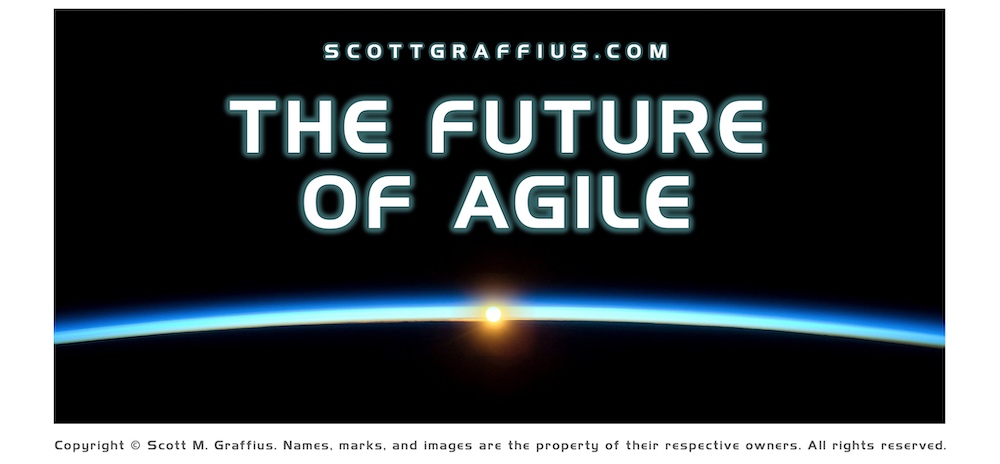
Click here to download this article as a PDF.
A Brief Overview of Agile
Organizations are increasingly adopting Agile approaches — such as Scrum, Kanban, SAFe, and others — to develop products and services. Some of the top reasons are:
The Future of Agile
As technology advances and business environments become more complex, Agile remains a powerful approach for organizations to stay competitive and deliver value to their customers. This article explores trends shaping the future of Agile and the key factors that contribute to its success.
Scaling Agile
One of the key trends shaping the future of Agile is scaling. Many organizations are looking for ways to scale Agile across teams, departments, and even the entire organization. Doing so involves adopting frameworks like the Scaled Agile Framework (SAFe), Large-Scale Scrum (LeSS), Disciplined Agile (DA), and others to coordinate and align multiple Agile teams to achieve common goals. Scaling Agile is essential to ensure that Agile practices are consistent across the organization, and that teams are working towards the same objectives.
Agile and DevOps
DevOps is another trend shaping the future of Agile. DevOps is a natural extension of Agile principles and values. DevOps aims to integrate development and operations teams to improve collaboration, streamline processes, and accelerate software delivery. As organizations increasingly embrace DevOps, Agile teams will need to incorporate DevOps practices into their workflow. This means that Agile teams will need to work more closely with operations teams and adopt new tools and practices to manage infrastructure and deployment.
Agile for Non-Tech Projects
Agile approaches were initially developed for software development projects. However, Agile principles and values can be applied to non-tech projects as well, such as marketing, HR, and finance. As organizations look for ways to improve their processes and adapt to change quickly, Agile will continue to gain traction in non-tech areas.
Agile with AI
Artificial intelligence (AI) is transforming the way businesses operate. Agile teams can leverage AI tools and techniques to improve software quality, automate testing, and optimize project management. As AI continues to evolve, Agile teams will need to adapt their processes and practices to best incorporate AI. Agile teams will need to work closely with data scientists and machine learning experts to identify opportunities to use AI in their projects.
Agile for Remote Teams
The COVID-19 pandemic has accelerated the trend of remote work. Agile teams need to adapt their processes to work effectively in a remote environment. This includes adopting new collaboration tools, establishing clear communication channels, and adapting Agile events (previously referred to as ceremonies) to work in a virtual setting.
Conclusion
The future of Agile is bright. Organizations are increasingly adopting Agile approaches to the development of products and services. By embracing trends — such as Scaling Agile, Agile and DevOps, Agile for non-tech, Agile with AI, and Agile for remote teams — and advances in technology, organizations can improve their Agile implementations and competitive advantage.




About Scott M. Graffius

Scott M. Graffius, PMP, CSP-SM, CSP-PO, CSM, CSPO, SFE, ITIL, LSSGB is an agile project management practitioner, consultant, multi award-winning author, and highly sought-after international keynote speaker. He has generated over $1.75 billion of business value in aggregate for the organizations he has served. Graffius is the CEO and Principal Consultant at Exceptional PPM and PMO Solutions™ and subsidiary Exceptional Agility™. Content from his books, talks, workshops, and more have been featured and used by businesses, professional associations, governments, and universities. Select examples include Microsoft, Oracle, Broadcom, Cisco, Gartner, Project Management Institute, IEEE, U.S. Soccer Federation, Qantas, National Academy of Sciences, U.S. Department of Energy, U.S. National Park Service, New Zealand Ministry of Education, Yale University, Warsaw University of Technology, and others. Graffius has delighted audiences with dynamic and engaging talks and workshops on agile, project management, and technology leadership at 82 conferences and other events across 24 countries.
His full bio is available here.
Connect with Scott on:
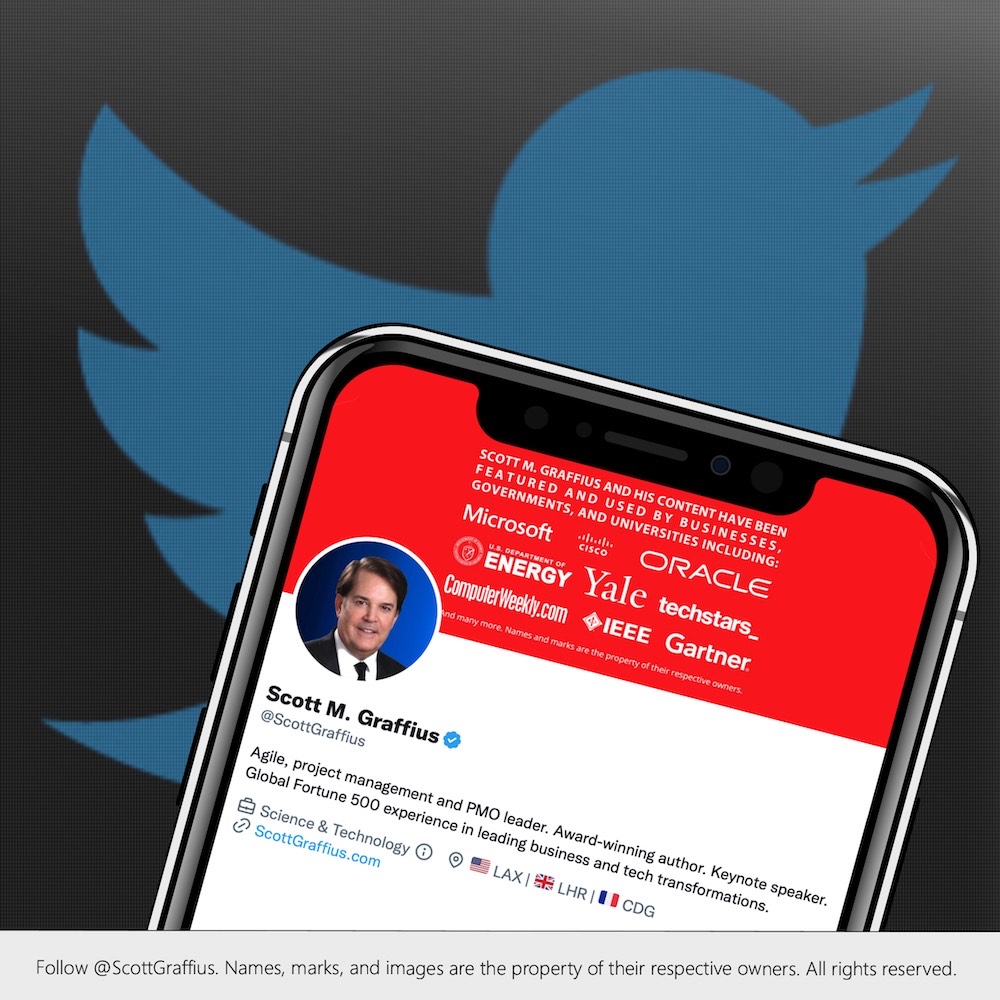

About Agile Scrum: Your Quick Start Guide with Step-by-Step Instructions

Shifting customer needs are common in today's marketplace. Businesses must be adaptive and responsive to change while delivering an exceptional customer experience to be competitive.
There are a variety of frameworks supporting the development of products and services, and most approaches fall into one of two broad categories: traditional or agile. Traditional practices such as waterfall engage sequential development, while agile involves iterative and incremental deliverables. Organizations are increasingly embracing agile to manage projects, and best meet their business needs of rapid response to change, fast delivery speed, and more.
With clear and easy to follow instructions, the multi award-winning Agile Scrum: Your Quick Start Guide with Step-by-Step Instructions book by Scott M. Graffius (Chris Hare and Colin Giffen, Technical Editors) helps the reader:
Hailed by Literary Titan as “the book highlights the versatility of Scrum beautifully.”
Winner of 17 first place awards.
Agile Scrum: Your Quick Start Guide with Step-by-Step Instructions is available in paperback and ebook/Kindle in the United States and around the world. Some links by country follow.

About Agile Transformation: A Brief Story of How an Entertainment Company Developed New Capabilities and Unlocked Business Agility to Thrive in an Era of Rapid Change

Thriving in today's marketplace frequently depends on making a transformation to become more agile. Those successful in the transition enjoy faster delivery speed and ROI, higher satisfaction, continuous improvement, and additional benefits.
Based on actual events, Agile Transformation: A Brief Story of How an Entertainment Company Developed New Capabilities and Unlocked Business Agility to Thrive in an Era of Rapid Change provides a quick (60-90 minute) read about a successful agile transformation at a multinational entertainment and media company, told from the author's perspective as an agile coach.
The award-winning book by Scott M. Graffius is available in paperback and ebook/Kindle in the United States and around the world. Some links by country follow.

The short URL for this article is: https://bit.ly/agile-future
© Copyright 2023 Scott M. Graffius. All rights reserved. This material may not be published, broadcast, rewritten or redistributed without the express written permission of Scott M. Graffius.


Click here to download this article as a PDF.
A Brief Overview of Agile
Organizations are increasingly adopting Agile approaches — such as Scrum, Kanban, SAFe, and others — to develop products and services. Some of the top reasons are:
- Flexibility: Agile approaches prioritize flexibility and the ability to adapt to changing requirements and circumstances easily. That’s advantageous in today's fast-paced business environment.
- Faster Time-to-Market: Agile approaches emphasize quick delivery of working products or services, which enables businesses to rapidly respond to market demands and gain a competitive edge.
- Customer-centric: Agile approaches focus on delivering value to customers, which helps businesses to better understand their needs and deliver products or services that meet those needs.
- Collaboration: Agile approaches encourage collaboration and communication between team members, which helps to create a more cohesive and productive team.
- Continuous improvement: Agile approaches prioritize continuous improvement, allowing teams to reflect on their performance and adjust their approach as needed to improve productivity and efficiency.
The Future of Agile
As technology advances and business environments become more complex, Agile remains a powerful approach for organizations to stay competitive and deliver value to their customers. This article explores trends shaping the future of Agile and the key factors that contribute to its success.
Scaling Agile
One of the key trends shaping the future of Agile is scaling. Many organizations are looking for ways to scale Agile across teams, departments, and even the entire organization. Doing so involves adopting frameworks like the Scaled Agile Framework (SAFe), Large-Scale Scrum (LeSS), Disciplined Agile (DA), and others to coordinate and align multiple Agile teams to achieve common goals. Scaling Agile is essential to ensure that Agile practices are consistent across the organization, and that teams are working towards the same objectives.
Agile and DevOps
DevOps is another trend shaping the future of Agile. DevOps is a natural extension of Agile principles and values. DevOps aims to integrate development and operations teams to improve collaboration, streamline processes, and accelerate software delivery. As organizations increasingly embrace DevOps, Agile teams will need to incorporate DevOps practices into their workflow. This means that Agile teams will need to work more closely with operations teams and adopt new tools and practices to manage infrastructure and deployment.
Agile for Non-Tech Projects
Agile approaches were initially developed for software development projects. However, Agile principles and values can be applied to non-tech projects as well, such as marketing, HR, and finance. As organizations look for ways to improve their processes and adapt to change quickly, Agile will continue to gain traction in non-tech areas.
Agile with AI
Artificial intelligence (AI) is transforming the way businesses operate. Agile teams can leverage AI tools and techniques to improve software quality, automate testing, and optimize project management. As AI continues to evolve, Agile teams will need to adapt their processes and practices to best incorporate AI. Agile teams will need to work closely with data scientists and machine learning experts to identify opportunities to use AI in their projects.
Agile for Remote Teams
The COVID-19 pandemic has accelerated the trend of remote work. Agile teams need to adapt their processes to work effectively in a remote environment. This includes adopting new collaboration tools, establishing clear communication channels, and adapting Agile events (previously referred to as ceremonies) to work in a virtual setting.
Conclusion
The future of Agile is bright. Organizations are increasingly adopting Agile approaches to the development of products and services. By embracing trends — such as Scaling Agile, Agile and DevOps, Agile for non-tech, Agile with AI, and Agile for remote teams — and advances in technology, organizations can improve their Agile implementations and competitive advantage.



About Scott M. Graffius

Scott M. Graffius, PMP, CSP-SM, CSP-PO, CSM, CSPO, SFE, ITIL, LSSGB is an agile project management practitioner, consultant, multi award-winning author, and highly sought-after international keynote speaker. He has generated over $1.75 billion of business value in aggregate for the organizations he has served. Graffius is the CEO and Principal Consultant at Exceptional PPM and PMO Solutions™ and subsidiary Exceptional Agility™. Content from his books, talks, workshops, and more have been featured and used by businesses, professional associations, governments, and universities. Select examples include Microsoft, Oracle, Broadcom, Cisco, Gartner, Project Management Institute, IEEE, U.S. Soccer Federation, Qantas, National Academy of Sciences, U.S. Department of Energy, U.S. National Park Service, New Zealand Ministry of Education, Yale University, Warsaw University of Technology, and others. Graffius has delighted audiences with dynamic and engaging talks and workshops on agile, project management, and technology leadership at 82 conferences and other events across 24 countries.
His full bio is available here.
Connect with Scott on:


About Agile Scrum: Your Quick Start Guide with Step-by-Step Instructions

Shifting customer needs are common in today's marketplace. Businesses must be adaptive and responsive to change while delivering an exceptional customer experience to be competitive.
There are a variety of frameworks supporting the development of products and services, and most approaches fall into one of two broad categories: traditional or agile. Traditional practices such as waterfall engage sequential development, while agile involves iterative and incremental deliverables. Organizations are increasingly embracing agile to manage projects, and best meet their business needs of rapid response to change, fast delivery speed, and more.
With clear and easy to follow instructions, the multi award-winning Agile Scrum: Your Quick Start Guide with Step-by-Step Instructions book by Scott M. Graffius (Chris Hare and Colin Giffen, Technical Editors) helps the reader:
- Implement and use the most popular agile framework―Scrum;
- Deliver products in short cycles with rapid adaptation to change, fast time-to-market, and continuous improvement; and
- Support innovation and drive competitive advantage.
Hailed by Literary Titan as “the book highlights the versatility of Scrum beautifully.”
Winner of 17 first place awards.
Agile Scrum: Your Quick Start Guide with Step-by-Step Instructions is available in paperback and ebook/Kindle in the United States and around the world. Some links by country follow.
- 🇧🇷 Brazil
- 🇨🇦 Canada
- 🇨🇿 Czech Republic
- 🇩🇰 Denmark
- 🇫🇮 Finland
- 🇫🇷 France
- 🇩🇪 Germany
- 🇬🇷 Greece
- 🇭🇺 Hungary
- 🇮🇳 India
- 🇮🇪 Ireland
- 🇮🇱 Israel
- 🇮🇹 Italy
- 🇯🇵 Japan
- 🇱🇺 Luxembourg
- 🇲🇽 Mexico
- 🇳🇱 Netherlands
- 🇳🇿 New Zealand
- 🇳🇴 Norway
- 🇪🇸 Spain
- 🇸🇪 Sweden
- 🇨🇭 Switzerland
- 🇦🇪 UAE
- 🇬🇧 United Kingdom
- 🇺🇸 United States

About Agile Transformation: A Brief Story of How an Entertainment Company Developed New Capabilities and Unlocked Business Agility to Thrive in an Era of Rapid Change

Thriving in today's marketplace frequently depends on making a transformation to become more agile. Those successful in the transition enjoy faster delivery speed and ROI, higher satisfaction, continuous improvement, and additional benefits.
Based on actual events, Agile Transformation: A Brief Story of How an Entertainment Company Developed New Capabilities and Unlocked Business Agility to Thrive in an Era of Rapid Change provides a quick (60-90 minute) read about a successful agile transformation at a multinational entertainment and media company, told from the author's perspective as an agile coach.
The award-winning book by Scott M. Graffius is available in paperback and ebook/Kindle in the United States and around the world. Some links by country follow.
- 🇦🇺 Australia
- 🇦🇹 Austria
- 🇧🇷 Brazil
- 🇨🇦 Canada
- 🇨🇿 Czech Republic
- 🇩🇰 Denmark
- 🇫🇮 Finland
- 🇫🇷 France
- 🇩🇪 Germany
- 🇬🇷 Greece
- 🇮🇳 India
- 🇮🇪 Ireland
- 🇯🇵 Japan
- 🇱🇺 Luxembourg
- 🇲🇽 Mexico
- 🇳🇱 Netherlands
- 🇳🇿 New Zealand
- 🇪🇸 Spain
- 🇸🇪 Sweden
- 🇨🇭 Switzerland
- 🇦🇪 United Arab Emirates
- 🇬🇧 United Kingdom
- 🇺🇸 United States

The short URL for this article is: https://bit.ly/agile-future
© Copyright 2023 Scott M. Graffius. All rights reserved. This material may not be published, broadcast, rewritten or redistributed without the express written permission of Scott M. Graffius.

Zittau/Görlitz University of Applied Sciences Features Scott M. Graffius' Content
26 April 2023
BY SCOTT M. GRAFFIUS | ScottGraffius.com
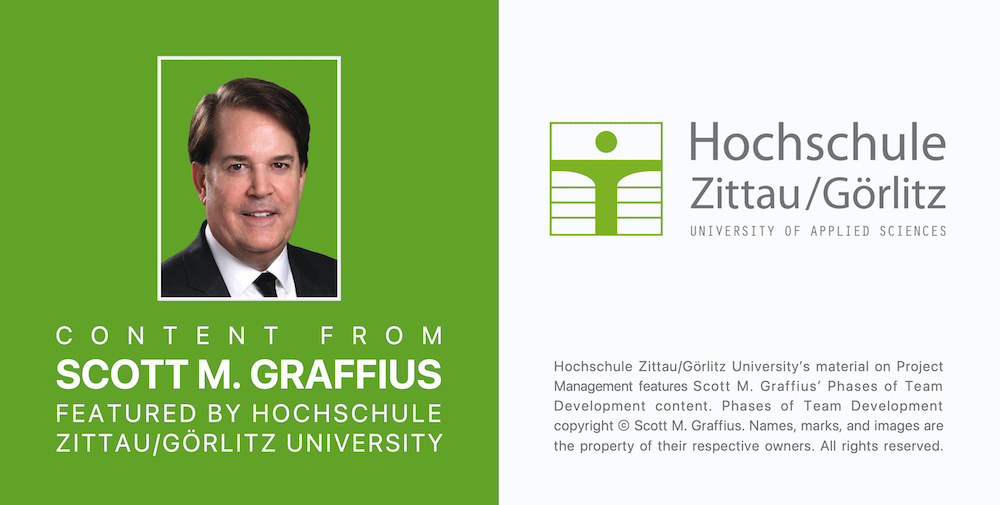
Select here to download this article as a PDF.
Businesses, professional associations, governments, and universities have used and featured Scott M. Graffius and content from his books, talks, workshops, and more. Examples of organizations include Microsoft, Oracle, Broadcom, Cisco, Gartner, Project Management Institute, IEEE, National Academy of Sciences, United States Department of Energy, New Zealand Ministry of Education, Yale University, Tufts University, and many others.
This month, Hochschule Zittau/Görlitz (Zittau/Görlitz University of Applied Sciences) was added to the list of organizations. Dr. Ingo Cassack, Professor at the university, incorporated Graffius' Phases of Team Development work into Dr. Cassack's material on project management. Two excerpts follow.
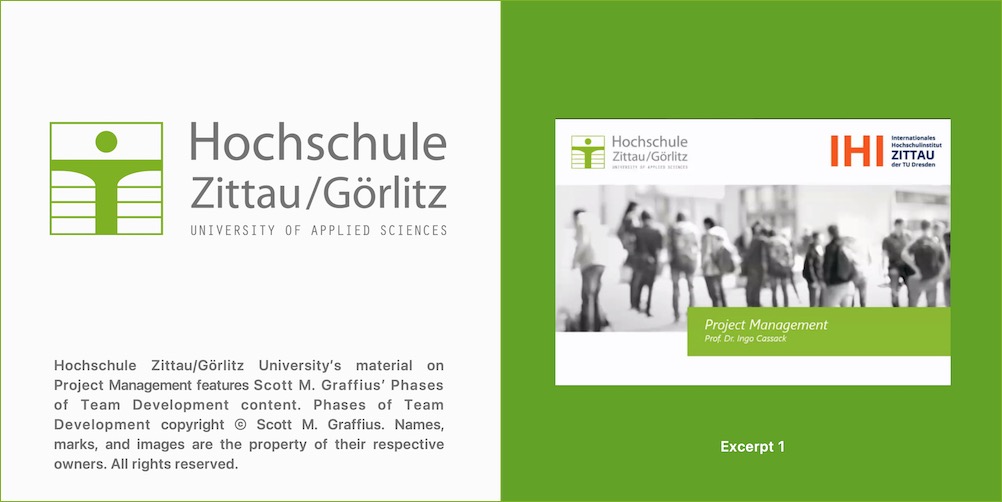
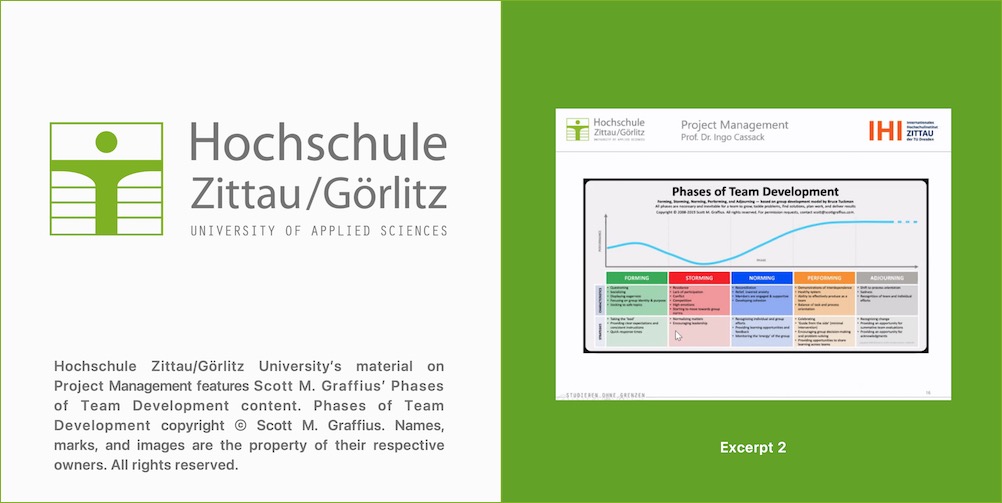
To learn more about Scott M. Graffius' Phases of Team Development, visit here.
Oksana Makovoz wrote about the presentation which included Graffius' work, among other details. She posted on:
About Hochschule Zittau/Görlitz
Hochschule Zittau/Görlitz (Zittau/Görlitz University of Applied Sciences) is a non-profit public higher-education institution located in Zittau — in the border triangle between Germany, the Czech Republic, and Poland . The institution also has a branch campus in Görlitz, Saxon, Germany. Officially recognized by the Sächsisches Staatsministerium für Wissenschaft und Kunst (Saxon State Ministry of Science and the Arts), Hochschule Zittau/Görlitz is a top tier coeducational German higher education institution with no tuition fees, state-of-the-art equipment, and intensive support. Visit https://www.hszg.de to learn more.




About Scott M. Graffius

Scott M. Graffius, PMP, SA, CSP-SM, CSP-PO, CSM, CSPO, SFE, ITIL, LSSGB is an agile project management practitioner, consultant, multi-award-winning author, and international keynote speaker. He is the Founder of Exceptional PPM and PMO Solutions™ and subsidiary Exceptional Agility™. He has generated over $1.9 billion of business value in aggregate for Global Fortune 500 businesses and other organizations he has served. Graffius and content from his books, talks, workshops, and more have been featured and used by businesses, professional associations, governments, and universities. Examples include Microsoft, Oracle, Broadcom, Cisco, Gartner, Project Management Institute, IEEE, Qantas, National Academy of Sciences, United States Department of Energy, New Zealand Ministry of Education, Yale University, Tufts University, and others. He has delighted audiences with dynamic and engaging talks and workshops on agile, project management, and technology leadership at 85 conferences and other events across 25 countries.
His full bio is available here.
Connect with Scott on:


About Agile Scrum: Your Quick Start Guide with Step-by-Step Instructions

Shifting customer needs are common in today's marketplace. Businesses must be adaptive and responsive to change while delivering an exceptional customer experience to be competitive.
There are a variety of frameworks supporting the development of products and services, and most approaches fall into one of two broad categories: traditional or agile. Traditional practices such as waterfall engage sequential development, while agile involves iterative and incremental deliverables. Organizations are increasingly embracing agile to manage projects, and best meet their business needs of rapid response to change, fast delivery speed, and more.
With clear and easy to follow instructions, the multi award-winning Agile Scrum: Your Quick Start Guide with Step-by-Step Instructions book by Scott M. Graffius (Chris Hare and Colin Giffen, Technical Editors) helps the reader:
Hailed by Literary Titan as “the book highlights the versatility of Scrum beautifully.”
Winner of 17 first place awards.
Agile Scrum: Your Quick Start Guide with Step-by-Step Instructions is available in paperback and ebook/Kindle in the United States and around the world. Some links by country follow.

About Agile Transformation: A Brief Story of How an Entertainment Company Developed New Capabilities and Unlocked Business Agility to Thrive in an Era of Rapid Change

Thriving in today's marketplace frequently depends on making a transformation to become more agile. Those successful in the transition enjoy faster delivery speed and ROI, higher satisfaction, continuous improvement, and additional benefits.
Based on actual events, Agile Transformation: A Brief Story of How an Entertainment Company Developed New Capabilities and Unlocked Business Agility to Thrive in an Era of Rapid Change provides a quick (60-90 minute) read about a successful agile transformation at a multinational entertainment and media company, told from the author's perspective as an agile coach.
The award-winning book by Scott M. Graffius is available in paperback and ebook/Kindle in the United States and around the world. Some links by country follow.

The short URL for this article is: https://bit.ly/hszg-2023
© Copyright 2023 Scott M. Graffius. All rights reserved. This material may not be published, broadcast, rewritten or redistributed without the express written permission of Scott M. Graffius.


Select here to download this article as a PDF.
Businesses, professional associations, governments, and universities have used and featured Scott M. Graffius and content from his books, talks, workshops, and more. Examples of organizations include Microsoft, Oracle, Broadcom, Cisco, Gartner, Project Management Institute, IEEE, National Academy of Sciences, United States Department of Energy, New Zealand Ministry of Education, Yale University, Tufts University, and many others.
This month, Hochschule Zittau/Görlitz (Zittau/Görlitz University of Applied Sciences) was added to the list of organizations. Dr. Ingo Cassack, Professor at the university, incorporated Graffius' Phases of Team Development work into Dr. Cassack's material on project management. Two excerpts follow.


To learn more about Scott M. Graffius' Phases of Team Development, visit here.
Oksana Makovoz wrote about the presentation which included Graffius' work, among other details. She posted on:
About Hochschule Zittau/Görlitz
Hochschule Zittau/Görlitz (Zittau/Görlitz University of Applied Sciences) is a non-profit public higher-education institution located in Zittau — in the border triangle between Germany, the Czech Republic, and Poland . The institution also has a branch campus in Görlitz, Saxon, Germany. Officially recognized by the Sächsisches Staatsministerium für Wissenschaft und Kunst (Saxon State Ministry of Science and the Arts), Hochschule Zittau/Görlitz is a top tier coeducational German higher education institution with no tuition fees, state-of-the-art equipment, and intensive support. Visit https://www.hszg.de to learn more.



About Scott M. Graffius

Scott M. Graffius, PMP, SA, CSP-SM, CSP-PO, CSM, CSPO, SFE, ITIL, LSSGB is an agile project management practitioner, consultant, multi-award-winning author, and international keynote speaker. He is the Founder of Exceptional PPM and PMO Solutions™ and subsidiary Exceptional Agility™. He has generated over $1.9 billion of business value in aggregate for Global Fortune 500 businesses and other organizations he has served. Graffius and content from his books, talks, workshops, and more have been featured and used by businesses, professional associations, governments, and universities. Examples include Microsoft, Oracle, Broadcom, Cisco, Gartner, Project Management Institute, IEEE, Qantas, National Academy of Sciences, United States Department of Energy, New Zealand Ministry of Education, Yale University, Tufts University, and others. He has delighted audiences with dynamic and engaging talks and workshops on agile, project management, and technology leadership at 85 conferences and other events across 25 countries.
His full bio is available here.
Connect with Scott on:


About Agile Scrum: Your Quick Start Guide with Step-by-Step Instructions

Shifting customer needs are common in today's marketplace. Businesses must be adaptive and responsive to change while delivering an exceptional customer experience to be competitive.
There are a variety of frameworks supporting the development of products and services, and most approaches fall into one of two broad categories: traditional or agile. Traditional practices such as waterfall engage sequential development, while agile involves iterative and incremental deliverables. Organizations are increasingly embracing agile to manage projects, and best meet their business needs of rapid response to change, fast delivery speed, and more.
With clear and easy to follow instructions, the multi award-winning Agile Scrum: Your Quick Start Guide with Step-by-Step Instructions book by Scott M. Graffius (Chris Hare and Colin Giffen, Technical Editors) helps the reader:
- Implement and use the most popular agile framework―Scrum;
- Deliver products in short cycles with rapid adaptation to change, fast time-to-market, and continuous improvement; and
- Support innovation and drive competitive advantage.
Hailed by Literary Titan as “the book highlights the versatility of Scrum beautifully.”
Winner of 17 first place awards.
Agile Scrum: Your Quick Start Guide with Step-by-Step Instructions is available in paperback and ebook/Kindle in the United States and around the world. Some links by country follow.
- 🇧🇷 Brazil
- 🇨🇦 Canada
- 🇨🇿 Czech Republic
- 🇩🇰 Denmark
- 🇫🇮 Finland
- 🇫🇷 France
- 🇩🇪 Germany
- 🇬🇷 Greece
- 🇭🇺 Hungary
- 🇮🇳 India
- 🇮🇪 Ireland
- 🇮🇱 Israel
- 🇮🇹 Italy
- 🇯🇵 Japan
- 🇱🇺 Luxembourg
- 🇲🇽 Mexico
- 🇳🇱 Netherlands
- 🇳🇿 New Zealand
- 🇳🇴 Norway
- 🇪🇸 Spain
- 🇸🇪 Sweden
- 🇨🇭 Switzerland
- 🇦🇪 UAE
- 🇬🇧 United Kingdom
- 🇺🇸 United States

About Agile Transformation: A Brief Story of How an Entertainment Company Developed New Capabilities and Unlocked Business Agility to Thrive in an Era of Rapid Change

Thriving in today's marketplace frequently depends on making a transformation to become more agile. Those successful in the transition enjoy faster delivery speed and ROI, higher satisfaction, continuous improvement, and additional benefits.
Based on actual events, Agile Transformation: A Brief Story of How an Entertainment Company Developed New Capabilities and Unlocked Business Agility to Thrive in an Era of Rapid Change provides a quick (60-90 minute) read about a successful agile transformation at a multinational entertainment and media company, told from the author's perspective as an agile coach.
The award-winning book by Scott M. Graffius is available in paperback and ebook/Kindle in the United States and around the world. Some links by country follow.
- 🇦🇺 Australia
- 🇦🇹 Austria
- 🇧🇷 Brazil
- 🇨🇦 Canada
- 🇨🇿 Czech Republic
- 🇩🇰 Denmark
- 🇫🇮 Finland
- 🇫🇷 France
- 🇩🇪 Germany
- 🇬🇷 Greece
- 🇮🇳 India
- 🇮🇪 Ireland
- 🇯🇵 Japan
- 🇱🇺 Luxembourg
- 🇲🇽 Mexico
- 🇳🇱 Netherlands
- 🇳🇿 New Zealand
- 🇪🇸 Spain
- 🇸🇪 Sweden
- 🇨🇭 Switzerland
- 🇦🇪 United Arab Emirates
- 🇬🇧 United Kingdom
- 🇺🇸 United States

The short URL for this article is: https://bit.ly/hszg-2023
© Copyright 2023 Scott M. Graffius. All rights reserved. This material may not be published, broadcast, rewritten or redistributed without the express written permission of Scott M. Graffius.

Leverage the Power of the Minimum Viable Product (MVP)
15 May 2023
BY SCOTT M. GRAFFIUS | ScottGraffius.com
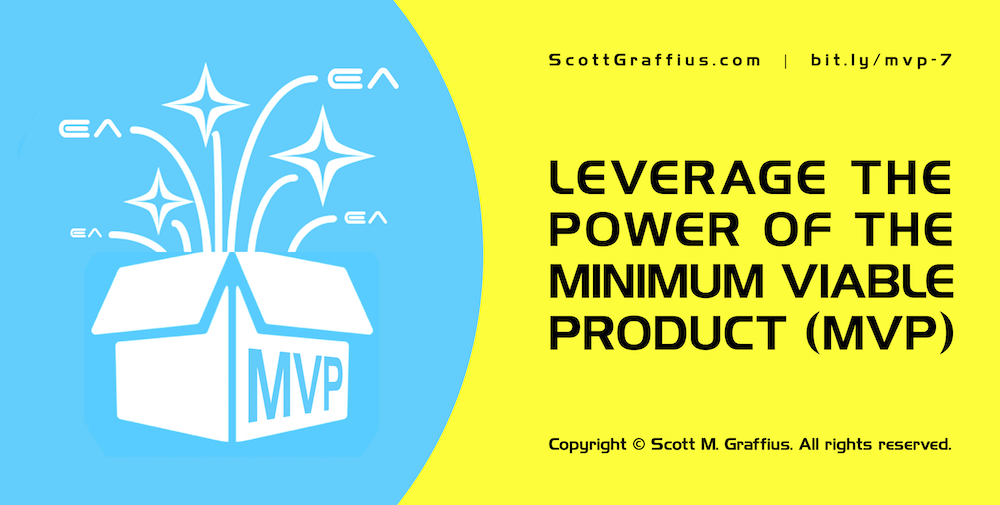
Select here to download this article as a PDF.
Minimum viable products (MVPs)—coined by Frank Robinson in 2001, and subsequently popularized by Steve Blank and Eric Ries—can be advantageous tools for the development of products and services. This article is informed by Graffius' first-hand experience with MVPs as well as research and coverage from the Harvard Business Review, IEEE, MIT Sloan Management Review, Product Development and Management Association, Product School, Project Management Institute, Scaled Agile, and others (all listed in the bibliography section of this article).

Introduction
Minimum Viable Products (MVPs) can be game changers. They can be used by businesses to validate ideas, reduce time to market, and minimize risks associated with building fully featured products from the outset. This article provides those involved or interested in Agile, Lean, Product Management, Product Development, Project Management, and entrepreneurship with information on the significance of MVPs and how to leverage them.

Defining MVPs
First, it's paramount to understand what constitutes an MVP and why it matters. A Minimum Viable Product is a version of a product (or service) that incorporates just the essential features to address core customer needs and validate the viability of the concept. By employing an MVP, companies can gather valuable user feedback early on, allowing them to iterate, refine, and pivot their offering—if needed—based on market demand. This process saves time and resources, and it advances the chances of building a successful and customer-centric offering.
Here's a succinct definition of the Minimum Viable Product (MVP):
"The MVP has just those features considered sufficient for it to be of value to customers and allow for it to be shipped or sold to early adopters. Customer feedback will inform future development of the product." — Scott M. Graffius, Agile Scrum: Your Quick Start Guide with Step-by-Step Instructions
Next, examples of seven successful MVPs—Zappos, Spotify, Airbnb, Facebook, Amazon, Dropbox, and Groupon—will illustrate the power of MVPs.
MVP Success Stories
Key Principles and Best Practices for MVPs
Building a successful MVP requires adhering to key principles and best practices. It involves thoughtfully determining the relatively few features and limited scope to address core customer needs. Collecting and analyzing user feedback plays a pivotal role in making informed decisions and prioritizing enhancements. By embracing an iterative mindset and focusing on the most valuable aspects of the product, businesses can create an MVP that resonates with their target audience.
Avoiding Common Pitfalls and Challenges with MVPs
While MVPs offer significant advantages, they are not without challenges. Over-engineering the product, prematurely scaling, and failing to validate crucial assumptions are common pitfalls that can hinder success. It’s vital to strike a balance between building a viable product and avoiding unnecessary complexity. By remaining adaptable and open to change, businesses can navigate these challenges and increase the chances of achieving their goals.
Validating and Iterating via Lean and Agile Approaches
The MVP is particularly well-suited for Lean and Agile approaches and environments. Lean principles emphasize continuous learning, eliminating waste, and rapid experimentation. Agile (such as Scrum, Kanban, and SAFe) involve iterative development, frequent feedback loops, and continuous improvement. Utilizing Lean/Agile can help maximize the value of MVPs and increase chances of success.
Beyond the MVP
Once an MVP proves its viability, the focus shifts to scaling and launching the product. This stage requires a broad and deep understanding of the target market, competition, and customer preferences. It involves adapting the product based on user feedback, exploring different marketing strategies, and leveraging data-driven insights. Staying agile, continuously learning, and adapting to market dynamics are crucial for sustained growth and long-term success.

Conclusion
MVPs are powerful tools for innovation and the successful development of products/services. The examples of Zappos, Spotify, Airbnb, Facebook, Amazon, Dropbox, and Groupon highlight the transformative impact of MVPs across diverse industries. By embracing the core principles, avoiding common pitfalls, and leveraging Lean and Agile approaches, businesses can unlock the full potential of their MVPs and pave the way for sustained growth, customer satisfaction, and market leadership with their offerings. Which makes MVPs game changers.

Bibliography

How to Cite This Article
Graffius, Scott M. (2023, May 15). Leverage the Power of the Minimum Viable Product (MVP). Available at: https://scottgraffius.com/blog/files/mvp2023.html. Digital Object Identifier (DOI): 10.13140/RG.2.2.24064.20486. DOI link: https://dx.doi.org/10.13140/RG.2.2.24064.20486.




About Scott M. Graffius
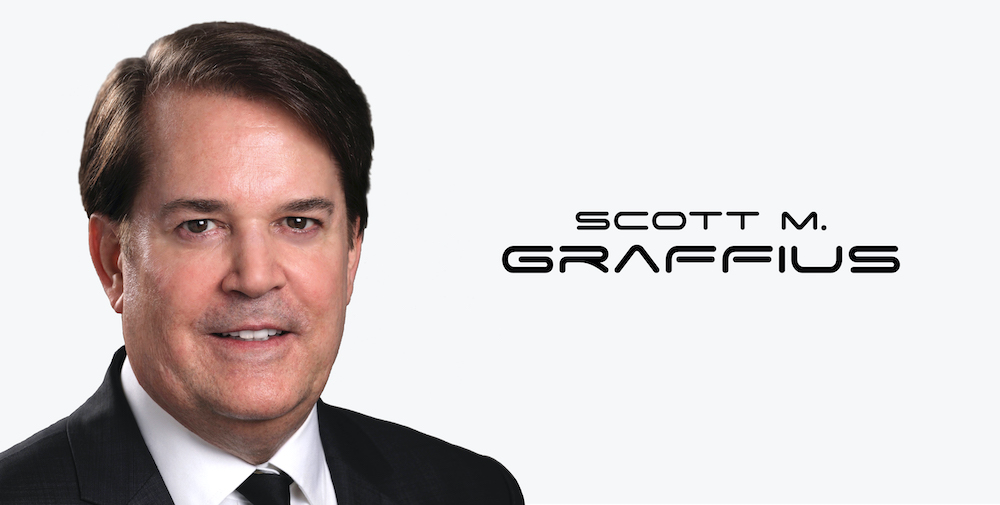
Scott M. Graffius, PMP, SA, CSP-SM, CSP-PO, CSM, CSPO, SFE, ITIL, LSSGB is an agile project management practitioner, consultant, multi-award-winning author, and international keynote speaker. He is the Founder of Exceptional PPM and PMO Solutions™ and subsidiary Exceptional Agility™. He has generated over $1.9 billion of business value in aggregate for Global Fortune 500 businesses and other organizations he has served. Graffius and content from his books, talks, workshops, and more have been featured and used by businesses, professional associations, governments, and universities. Examples include Microsoft, Oracle, Broadcom, Cisco, Gartner, Project Management Institute, IEEE, Qantas, National Academy of Sciences, United States Department of Energy, New Zealand Ministry of Education, Yale University, Tufts University, and others. He has delighted audiences with dynamic and engaging talks and workshops on agile, project management, and technology (including AI) leadership at 86 conferences and other events across 25 countries.
His full bio is available here.
Connect with Scott on:


About Agile Scrum: Your Quick Start Guide with Step-by-Step Instructions

Shifting customer needs are common in today's marketplace. Businesses must be adaptive and responsive to change while delivering an exceptional customer experience to be competitive.
There are a variety of frameworks supporting the development of products and services, and most approaches fall into one of two broad categories: traditional or agile. Traditional practices such as waterfall engage sequential development, while agile involves iterative and incremental deliverables. Organizations are increasingly embracing agile to manage projects, and best meet their business needs of rapid response to change, fast delivery speed, and more.
With clear and easy to follow instructions, the multi award-winning Agile Scrum: Your Quick Start Guide with Step-by-Step Instructions book by Scott M. Graffius (Chris Hare and Colin Giffen, Technical Editors) helps the reader:
Hailed by Literary Titan as “the book highlights the versatility of Scrum beautifully.”
Winner of 17 first place awards.
Agile Scrum: Your Quick Start Guide with Step-by-Step Instructions is available in paperback and ebook/Kindle in the United States and around the world. Some links by country follow.

About Agile Transformation: A Brief Story of How an Entertainment Company Developed New Capabilities and Unlocked Business Agility to Thrive in an Era of Rapid Change

Thriving in today's marketplace frequently depends on making a transformation to become more agile. Those successful in the transition enjoy faster delivery speed and ROI, higher satisfaction, continuous improvement, and additional benefits.
Based on actual events, Agile Transformation: A Brief Story of How an Entertainment Company Developed New Capabilities and Unlocked Business Agility to Thrive in an Era of Rapid Change provides a quick (60-90 minute) read about a successful agile transformation at a multinational entertainment and media company, told from the author's perspective as an agile coach.
The award-winning book by Scott M. Graffius is available in paperback and ebook/Kindle in the United States and around the world. Some links by country follow.

The short URL for this article is: https://bit.ly/mvp-7
© Copyright 2023 Scott M. Graffius. All rights reserved. This material may not be published, broadcast, rewritten or redistributed without the express written permission of Scott M. Graffius.


Select here to download this article as a PDF.
Minimum viable products (MVPs)—coined by Frank Robinson in 2001, and subsequently popularized by Steve Blank and Eric Ries—can be advantageous tools for the development of products and services. This article is informed by Graffius' first-hand experience with MVPs as well as research and coverage from the Harvard Business Review, IEEE, MIT Sloan Management Review, Product Development and Management Association, Product School, Project Management Institute, Scaled Agile, and others (all listed in the bibliography section of this article).

Introduction
Minimum Viable Products (MVPs) can be game changers. They can be used by businesses to validate ideas, reduce time to market, and minimize risks associated with building fully featured products from the outset. This article provides those involved or interested in Agile, Lean, Product Management, Product Development, Project Management, and entrepreneurship with information on the significance of MVPs and how to leverage them.

Defining MVPs
First, it's paramount to understand what constitutes an MVP and why it matters. A Minimum Viable Product is a version of a product (or service) that incorporates just the essential features to address core customer needs and validate the viability of the concept. By employing an MVP, companies can gather valuable user feedback early on, allowing them to iterate, refine, and pivot their offering—if needed—based on market demand. This process saves time and resources, and it advances the chances of building a successful and customer-centric offering.
Here's a succinct definition of the Minimum Viable Product (MVP):
"The MVP has just those features considered sufficient for it to be of value to customers and allow for it to be shipped or sold to early adopters. Customer feedback will inform future development of the product." — Scott M. Graffius, Agile Scrum: Your Quick Start Guide with Step-by-Step Instructions
Next, examples of seven successful MVPs—Zappos, Spotify, Airbnb, Facebook, Amazon, Dropbox, and Groupon—will illustrate the power of MVPs.
MVP Success Stories
- Zappos: Zappos revolutionized the online shoe market by focusing on customer-centricity and rapid experimentation. Their MVP allowed them to validate their hypothesis, gather customer feedback, and iterate their offering to create a seamless and personalized shopping experience. Zappos is a prime example of the power of MVPs.
- Spotify: Global music streaming platform Spotify started as a simple streaming service MVP and they and continuously improved and expanded it based on customer feedback. By iterating their product, Spotify became a household name. Their MVP-driven approach ensured a product-market fit and helped them stay ahead in a competitive industry.
- Airbnb: Airbnb's success story speaks to the effectiveness of MVPs in validating an idea and subsequently scaling it to a global marketplace. Airbnb's founders started by testing their marketplace concept using an MVP strategy. By leveraging existing resources and validating demand through early adopters, they gained critical insights that shaped their platform's evolution. Today, Airbnb is a household name, offering unique accommodations worldwide.
- Facebook: Facebook's journey from a simple MVP to the world's largest social network demonstrates the power of incremental growth and user feedback. Mark Zuckerberg and fellow Harvard College students and roommates Eduardo Saverin, Andrew McCollum, Dustin Moskovitz, and Chris Hughes initially created a minimal profile-based social networking MVP (initially called "Thefacebook"), focusing on connecting people at Harvard. Through continuous iterations and the addition of features based on user needs and feedback, Facebook reshaped the social media landscape, connecting billions of people globally.
- Amazon: E-commerce giant Amazon is renowned for its relentless focus on customer experience. They started with an MVP approach, catering to customers' fundamental needs related to books, and subsequently expanded into new product categories incrementally. By prioritizing customer satisfaction, Amazon established itself as a trusted and innovative marketplace, continuously raising the bar for online shopping.
- Dropbox: Dropbox, a prominent player in the cloud storage market, kick-started its journey with a basic file-syncing MVP. By offering a simple yet essential solution to the problem of file synchronization across devices, Dropbox gained traction and valuable user insights. They leveraged this feedback to iterate and improve their product, eventually becoming a leader in the highly competitive cloud storage industry.
- Groupon: Popular online deals platform Groupon employed an MVP approach by testing deal offerings on a WordPress blog. That allowed them to validate market interest and adjust their strategy based on customer responses. By embracing the importance of market validation and adaptability, Groupon transformed into a global leader, providing users with discounted offers across various categories.
Key Principles and Best Practices for MVPs
Building a successful MVP requires adhering to key principles and best practices. It involves thoughtfully determining the relatively few features and limited scope to address core customer needs. Collecting and analyzing user feedback plays a pivotal role in making informed decisions and prioritizing enhancements. By embracing an iterative mindset and focusing on the most valuable aspects of the product, businesses can create an MVP that resonates with their target audience.
Avoiding Common Pitfalls and Challenges with MVPs
While MVPs offer significant advantages, they are not without challenges. Over-engineering the product, prematurely scaling, and failing to validate crucial assumptions are common pitfalls that can hinder success. It’s vital to strike a balance between building a viable product and avoiding unnecessary complexity. By remaining adaptable and open to change, businesses can navigate these challenges and increase the chances of achieving their goals.
Validating and Iterating via Lean and Agile Approaches
The MVP is particularly well-suited for Lean and Agile approaches and environments. Lean principles emphasize continuous learning, eliminating waste, and rapid experimentation. Agile (such as Scrum, Kanban, and SAFe) involve iterative development, frequent feedback loops, and continuous improvement. Utilizing Lean/Agile can help maximize the value of MVPs and increase chances of success.
Beyond the MVP
Once an MVP proves its viability, the focus shifts to scaling and launching the product. This stage requires a broad and deep understanding of the target market, competition, and customer preferences. It involves adapting the product based on user feedback, exploring different marketing strategies, and leveraging data-driven insights. Staying agile, continuously learning, and adapting to market dynamics are crucial for sustained growth and long-term success.

Conclusion
MVPs are powerful tools for innovation and the successful development of products/services. The examples of Zappos, Spotify, Airbnb, Facebook, Amazon, Dropbox, and Groupon highlight the transformative impact of MVPs across diverse industries. By embracing the core principles, avoiding common pitfalls, and leveraging Lean and Agile approaches, businesses can unlock the full potential of their MVPs and pave the way for sustained growth, customer satisfaction, and market leadership with their offerings. Which makes MVPs game changers.

Bibliography
- Airbnb (n.d.). About Airbnb. Available at: https://news.airbnb.com/about-us.
- Blank, Steve (2020). The Startup Owner's Manual: The Step-By-Step Guide for Building a Great Company. Hoboken, New Jersey: John Wiley and Sons.
- Cagan, Marty (2012, March 7). Viable Product vs. Minimal Product. Silicon Valley Product Group (SVPG). Available at: https://www.svpg.com/viable-product-vs-minimal-product.
- CB Insights (2021, August 3). The Top 12 Reasons Startups Fail. CB Insights Research. Available at: https://www.cbinsights.com/research/report/startup-failure-reasons-top.
- Davenport, Thomas H., & Seseri, Rudina (2020, December 15). What is a Minimum Viable AI Product? MIT Sloan Management Review. Available at: https://sloanreview.mit.edu/article/what-is-a-minimum-viable-ai-product.
- Dropbox (n.d.). About the Company. Available at: https://www.dropbox.com/about.
- Furr, Nathan, & Dyer, Jeff (2014). The Innovator's Method: Bringing the Lean Start-up into Your Organization. Boston, Massachusetts: Harvard Business Review Press.
- Graffius, Scott M. (2016). Agile Scrum: Your Quick Start Guide with Step-by-Step Instructions. North Charleston, SC: CreateSpace.
- Graffius, Scott M. (2018, October 4). Agile Scrum Helps Innovators, Disruptors, and Entrepreneurs Develop and Deliver Products at Astounding Speed Which Drives Competitive Advantage [Presentation]. Talk delivered to an audience of startups and others in the entrepreneurial community at the Techstars Startup Week Conference at The Box Theater, Riverside, California, United States. Digital Object Identifier (DOI): 10.13140/RG.2.2.25009.12647. DOI link: https://dx.doi.org/10.13140/RG.2.2.25009.12647.
- Graffius, Scott M. (2021, February 27). Are You Realizing All the Benefits from Agile? [Presentation]. Talk delivered to an audience involved or interested in Technology at the Scottish Summit 2021 Technology Conference based from Glasgow, Scotland, United Kingdom. Digital Object Identifier (DOI): 10.13140/RG.2.2.17273.90728. DOI link: https://dx.doi.org/10.13140/RG.2.2.17273.90728.
- Graffius, Scott M. (2023, May 1). Fueling the Development of Innovative and Life-Changing AI Solutions [Presentation]. Talk delivered to an audience of Technology professionals (including Data Scientists, Machine Learning Engineers, Data Engineers, AI Researchers, Project Managers, Business Analysts, UX Designers, Software Developers, Cloud Architects, Data Privacy and Security Specialists, and others involved or interested in AI) at a private event in Mountain View, California, United States. Digital Object Identifier (DOI): 10.13140/RG.2.2.27956.73601. DOI link: https://dx.doi.org/10.13140/RG.2.2.27956.73601.
- Groupon (2013, July 30). The History of Groupon. Available at: https://www.groupon.com/merchant/working-with-groupon/groupon-news/the-history-of-groupon.
- Harvard Business School (2021). MVP Development. Available at: https://entrepreneurship.hbs.edu/Documents/Session%20Summary/HBSRockMVPDevelopment.pdf.
- Krishnamurthy, Rajeshwari (2021, January 29). Why is Agile Product Development Process So Popular? Product Development & Management Association (PDMA). Available at: https://community.pdma.org/knowledgehub/bok/product-innovation-process/why-is-agile-product-development-process-so-popular.
- Lenarduzzi, Valentina, & Taibi, Davide (2016, August). MVP Explained: A Systematic Mapping Study on the Definitions of Minimal Viable Product. Proceedings from the 2016 42nd Euromicro Conference on Software Engineering and Advanced Applications (SEAA): 112–119.
- Merryweather, Ellen (2023, January 9). Product-Led Growth Strategy for Product Managers. Product School. Available at: https://productschool.com/blog/product-strategy/product-led-growth-strategy.
- Meta (n.d.). About Meta. Available at: https://about.meta.com/company-info.
- Miski, A. (2014). Development of a Mobile Application Using the Lean Startup Methodology. International Journal of Scientific & Engineering Research, 5 (1): 1743-1748.
- Moogk, Dobrila R. (2012, March). Minimum Viable Product and the Importance of Experimentation in Technology Startups. Technology Innovation and Management Review. Available at: https://timreview.ca/article/535.
- Olsen, Dan (2015). The Lean Product Playbook: How to Innovate with Minimum Viable Products and Rapid Customer Feedback. Hoboken, New Jersey: John Wiley and Sons.
- Osterwalder, Alexander, & Pigneur, Yves (2010). Business Model Generation: A Handbook for Visionaries, Game Changers, and Challengers. Hoboken, New Jersey: John Wiley and Sons.
- Project Management Institute (n.d.). Minimum Business Increments (MBIs). Available at: https://www.pmi.org/disciplined-agile/da-flex-toc/minimum-business-increments.
- Putten, Alexander B. van, & MacMillan, Ian (2004, December). Making Real Options Really Work. Harvard Business Review, 82 (12): 134-141, 150.
- Ries, Eric (2011). The Lean Startup: How Today's Entrepreneurs Use Continuous Innovation to Create Radically Successful Businesses. New York, New York: Penguin Random House.
- Scaled Agile (n.d.). Applied Innovation Accounting in SAFe. Available at: https://scaledagileframework.com/guidance-applied-innovation-accounting-in-safe.
- Spotify (n.d.). About Spotify. Available at: https://newsroom.spotify.com/company-info.
- Templeton, Chuck (2014, December 9). 10 Lessons Every Entrepreneur Should Learn. Fortune. Available at: https://fortune.com/2014/12/09/10-lessons-every-entrepreneur-should-learn.
- Thomsen, Dave (2013, December 20). Why Human-Centered Design Matters. Wired. Available at: https://www.wired.com/insights/2013/12/human-centered-design-matters.
- Umbreen, J., Mirza, Muhammad Z., Ahmad, Yasir, & Naseem, Afshan. (2022, December). Assessing the Role of Minimum Viable Products in Digital Startups. Proceedings of the 2022 IEEE International Conference on Industrial Engineering and Engineering Management (IEEM): 1073-1077.
- Wikipedia (n.d.). History of Amazon. Available at: https://en.wikipedia.org/wiki/History_of_Amazon.
- Zappos (n.d.). About Zappos. Available at: https://www.zappos.com/marty/c/about-zappos.

How to Cite This Article
Graffius, Scott M. (2023, May 15). Leverage the Power of the Minimum Viable Product (MVP). Available at: https://scottgraffius.com/blog/files/mvp2023.html. Digital Object Identifier (DOI): 10.13140/RG.2.2.24064.20486. DOI link: https://dx.doi.org/10.13140/RG.2.2.24064.20486.



About Scott M. Graffius

Scott M. Graffius, PMP, SA, CSP-SM, CSP-PO, CSM, CSPO, SFE, ITIL, LSSGB is an agile project management practitioner, consultant, multi-award-winning author, and international keynote speaker. He is the Founder of Exceptional PPM and PMO Solutions™ and subsidiary Exceptional Agility™. He has generated over $1.9 billion of business value in aggregate for Global Fortune 500 businesses and other organizations he has served. Graffius and content from his books, talks, workshops, and more have been featured and used by businesses, professional associations, governments, and universities. Examples include Microsoft, Oracle, Broadcom, Cisco, Gartner, Project Management Institute, IEEE, Qantas, National Academy of Sciences, United States Department of Energy, New Zealand Ministry of Education, Yale University, Tufts University, and others. He has delighted audiences with dynamic and engaging talks and workshops on agile, project management, and technology (including AI) leadership at 86 conferences and other events across 25 countries.
His full bio is available here.
Connect with Scott on:


About Agile Scrum: Your Quick Start Guide with Step-by-Step Instructions

Shifting customer needs are common in today's marketplace. Businesses must be adaptive and responsive to change while delivering an exceptional customer experience to be competitive.
There are a variety of frameworks supporting the development of products and services, and most approaches fall into one of two broad categories: traditional or agile. Traditional practices such as waterfall engage sequential development, while agile involves iterative and incremental deliverables. Organizations are increasingly embracing agile to manage projects, and best meet their business needs of rapid response to change, fast delivery speed, and more.
With clear and easy to follow instructions, the multi award-winning Agile Scrum: Your Quick Start Guide with Step-by-Step Instructions book by Scott M. Graffius (Chris Hare and Colin Giffen, Technical Editors) helps the reader:
- Implement and use the most popular agile framework―Scrum;
- Deliver products in short cycles with rapid adaptation to change, fast time-to-market, and continuous improvement; and
- Support innovation and drive competitive advantage.
Hailed by Literary Titan as “the book highlights the versatility of Scrum beautifully.”
Winner of 17 first place awards.
Agile Scrum: Your Quick Start Guide with Step-by-Step Instructions is available in paperback and ebook/Kindle in the United States and around the world. Some links by country follow.
- 🇧🇷 Brazil
- 🇨🇦 Canada
- 🇨🇿 Czech Republic
- 🇩🇰 Denmark
- 🇫🇮 Finland
- 🇫🇷 France
- 🇩🇪 Germany
- 🇬🇷 Greece
- 🇭🇺 Hungary
- 🇮🇳 India
- 🇮🇪 Ireland
- 🇮🇱 Israel
- 🇮🇹 Italy
- 🇯🇵 Japan
- 🇱🇺 Luxembourg
- 🇲🇽 Mexico
- 🇳🇱 Netherlands
- 🇳🇿 New Zealand
- 🇳🇴 Norway
- 🇪🇸 Spain
- 🇸🇪 Sweden
- 🇨🇭 Switzerland
- 🇦🇪 UAE
- 🇬🇧 United Kingdom
- 🇺🇸 United States

About Agile Transformation: A Brief Story of How an Entertainment Company Developed New Capabilities and Unlocked Business Agility to Thrive in an Era of Rapid Change

Thriving in today's marketplace frequently depends on making a transformation to become more agile. Those successful in the transition enjoy faster delivery speed and ROI, higher satisfaction, continuous improvement, and additional benefits.
Based on actual events, Agile Transformation: A Brief Story of How an Entertainment Company Developed New Capabilities and Unlocked Business Agility to Thrive in an Era of Rapid Change provides a quick (60-90 minute) read about a successful agile transformation at a multinational entertainment and media company, told from the author's perspective as an agile coach.
The award-winning book by Scott M. Graffius is available in paperback and ebook/Kindle in the United States and around the world. Some links by country follow.
- 🇦🇺 Australia
- 🇦🇹 Austria
- 🇧🇷 Brazil
- 🇨🇦 Canada
- 🇨🇿 Czech Republic
- 🇩🇰 Denmark
- 🇫🇮 Finland
- 🇫🇷 France
- 🇩🇪 Germany
- 🇬🇷 Greece
- 🇮🇳 India
- 🇮🇪 Ireland
- 🇯🇵 Japan
- 🇱🇺 Luxembourg
- 🇲🇽 Mexico
- 🇳🇱 Netherlands
- 🇳🇿 New Zealand
- 🇪🇸 Spain
- 🇸🇪 Sweden
- 🇨🇭 Switzerland
- 🇦🇪 United Arab Emirates
- 🇬🇧 United Kingdom
- 🇺🇸 United States

The short URL for this article is: https://bit.ly/mvp-7
© Copyright 2023 Scott M. Graffius. All rights reserved. This material may not be published, broadcast, rewritten or redistributed without the express written permission of Scott M. Graffius.

